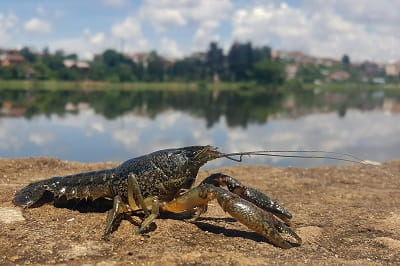The web Browser you are currently using is unsupported, and some features of this site may not work as intended. Please update to a modern browser such as Chrome, Firefox or Edge to experience all features Michigan.gov has to offer.
Invasive Species: Marbled Crayfish
Marbled Crayfish
(Procambarus virginalis)
*Not detected in Michigan*
WATCH LIST - PROHIBITED IN MICHIGAN
REPORT MARBLED CRAYFISH
- Katherine Quebedeaux, DNR Fisheries Division, QuebedeauxK@Michigan.gov, 734-780-5571.
WHAT TO LOOK FOR
- A medium-sized crayfish, ranging from 4 to 5 inches in length.
- A marbled color pattern most visible on its carapace or back.
- Coloring is generally olive to dark brown but can range from tan to reddish to blue.
- Claws are slender or narrow.

Marbled crayfish are named for the streaked or marbled appearance of the shell and claws. Photo courtesy of Ranja Adriantsoa.

- Native calico crayfish are small (2” to 3.5”) and generally grayish-green in color. Claw tips or pincers are orange, and purple-tinged in adult males.
- Native white river crayfish have larger, more rounded claws. Both claws and carapace are covered with raised bumps or tubercles.
- See photos of these native crayfish in the Crayfish of Michigan Poster.
ABOUT THIS SPECIES
Habitat: Marbled crayfish have been found in streams, rivers, ditches, ponds, wetlands and retention basins. They can survive in drought conditions by burrowing into the soil. Marbled crayfish have been observed migrating across land.
Native Range: Since the marbled crayfish originated in the pet trade, it does not exist anywhere as a wild native population. Since its discovery in the German pet trade in the 1990’s, marbled crayfish have established populations in the wild in Germany, Austria, Italy, the Netherlands, the UK, Japan and Madagascar.
U.S. Distribution: Marbled crayfish have not been detected in the wild in the U.S.
Michigan Distribution: Marbled crayfish have not been detected in the wild in Michigan.
Michigan Status: Marbled crayfish are prohibited in Michigan.
Local Concern: The marbled crayfish is the only known decapod crustacean that reproduces through parthenogenesis (i.e., ability to self-clone): all individuals are female and have the ability to lay up to 700 unfertilized eggs that develop into genetically identical offspring. With rapid reproduction and aggressive behavior, marbled crayfish can quickly dominate lakes, ponds and streams. Marbled crayfish feed on algae, plants, snails and amphibians and can out-compete native species including fish. Burrowing can destabilize banks and shorelines.
Means of Introduction and Spread: Marbled crayfish are widely available in the aquarium trade, creating a high risk of introduction and spread through the release of unwanted pets. Because of their cloning ability, a single individual can establish a population.
Management:
- Marbled crayfish have not been identified in public waters in Michigan but were available in the pet trade prior to being added to the Prohibited Species List in 2020. As such, preventing the release of this species from the pet trade is a high management priority. In addition, early detection and public reporting will be critical to detect marbled crayfish prior to establishment.
- In order to comply with the new invasive species order, owners of marbled crayfish should humanely dispose of any specimens in their possession and clean tanks thoroughly to assure no eggs or young remain. The American Veterinary Medical Association’s Guidelines for Euthanasia of Animals: 2020 Edition provides recommendations for humane disposal of aquatic invertebrates including crayfish. Note that flushing an aquatic animal down a drain or toilet is not considered humane and does not necessarily kill the animal but can introduce it into a water system.
- Preferred methods of disposal per the AVMA are to euthanize by submerging crayfish in clove oil, ethanol, or other anesthetics (Page 89 of AVMA). If those methods are not available, freezing crayfish for an extended period of time (> 48 hours) can also be used as an alternative euthanasia method.
MORE INFORMATION
- Field Guide to Michigan Crayfish
- Great Lakes Almanac to Invasive Crayfish Identification & Reporting
- Michigan crayfish poster
- Never release aquarium plants or animals – RIPPLE video
- Marbled Crayfish (Procambarus virginalis) Ecological Risk Screening Summary - U.S. Fish and Wildlife Service